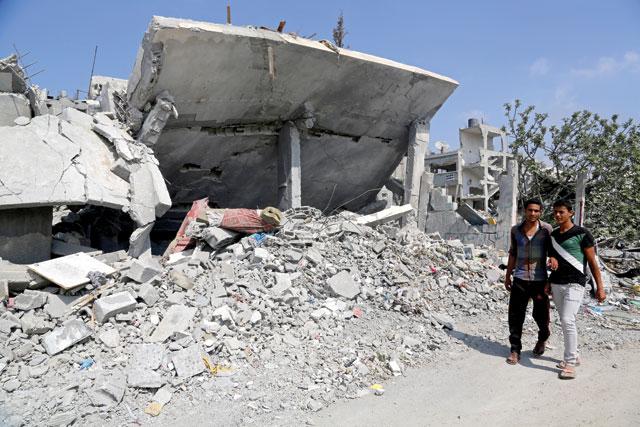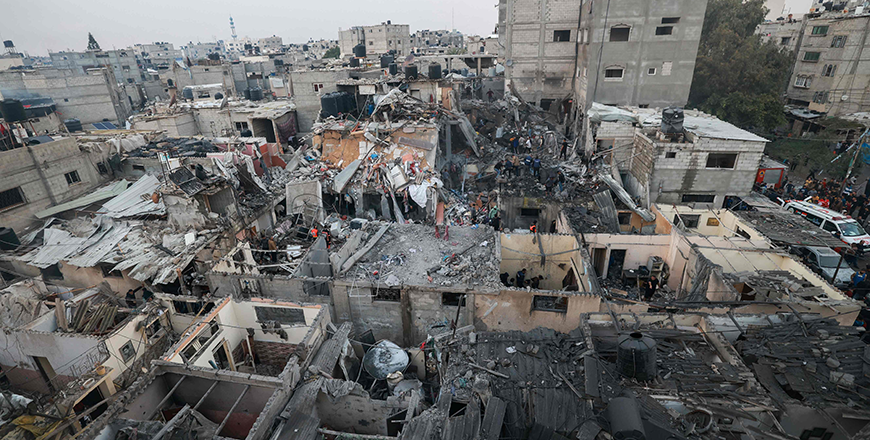You are here
Gaza's economy ‘on verge of collapse’ — World Bank
By Reuters - May 22,2015 - Last updated at May 22,2015
OCCUPIED JERUSALEM — Gaza's economy is in a worse state than any other in the world, with unemployment at a global high, output contracting sharply and the long-term prospects worrying, the World Bank said on Friday.
Repeated rounds of conflict, internal divisions and the embargo Israel and Egypt impose have left the territory "on the verge of collapse", the report said, with its 1.8 million population facing poverty and destitution despite vast aid.
"Blockades, war and poor governance have strangled Gaza's economy and the unemployment rate is now the highest in the world," indicated the report, drafted by Steen Lau Jorgensen, the World Bank's director for Gaza and the West Bank.
It is to be presented in Brussels on May 27.
"Gaza's exports virtually disappeared and the manufacturing sector has shrunk by as much as 60 per cent. The economy cannot survive without being connected to the outside world," the report said.
Among the startling statistics cited in the report are:
Overall unemployment now stands at 43 per cent, and 68 per cent among those aged 20-24.
Gaza's current real gross domestic product (GDP) is only a couple of percentage points higher than it was 20 years ago. Over the same period, the population has increased by 230 per cent.
Last year's war between Israel and Hamas led to a 15 per cent contraction in GDP for the year.
Real per capita income in Gaza is now 31 per cent lower than it was in 1994.
Between 1994 and 2012, Gaza's manufacturing sector, which should be the driver of the economy, shrank by 60 per cent.
Disease a threat
While the World Bank tracks Gaza's malaise back more than 20 years, the economic deterioration has accelerated since 2006, when Hamas won elections and began running the territory, taking over full control in 2007.
Since then, there have been three wars between Hamas and Israel, with Hamas firing rockets across the border and Israel responding with artillery, air strikes and ground forces.
The war in July-August 2014 was the most devastating, with more than 2,000 Palestinians killed and 120,000 houses damaged or destroyed. More than 70 Israelis were also killed.
On top of the conflicts, internal divisions have conspired against Gaza, with Palestinian leaders in the West Bank determined to freeze out Hamas and its authoritarian rule.
And then the blockade, first imposed by Israel in 2007 and later joined by Egypt, has compounded the problems: exports from Gaza have fallen to almost zero since 2007, while imports are equally small and heavily restricted.
As well as the raw economic impact, the World Bank highlighted the socioeconomic and mental toll the situation is having. More than 80 per cent of Gazans receive some form of aid, but 40 per cent remain below the poverty line.
Mental health and trauma experts estimate that a third of children displayed signs of post-traumatic stress disorder even before the 2014 conflict.
"The status quo in Gaza is unsustainable," Jorgensen said in the 40-page analysis. "The feeling of hopelessness is pervasive, in particular following the summer 2014 war.”
"The access and quality of basic services such as electricity, water and sewerage is rapidly deteriorating and pandemics of infectious diseases are a real threat," he concluded.
Related Articles
Envoys from dozens of countries will gather Sunday for a conference that aims to raise billions of dollars to rebuild conflict-battered Gaza, despite fears of renewed violence and "donor fatigue".
WASHINGTON — The Hamas-Israel war in Gaza is having a severe impact on the Palestinian economy, the World Bank said on Tuesday, adding that
OCCUPIED JERUSALEM — Israel said on Wednesday it would issue 3,000 more permits for merchants from Gaza to enter Israel, the latest measure


















